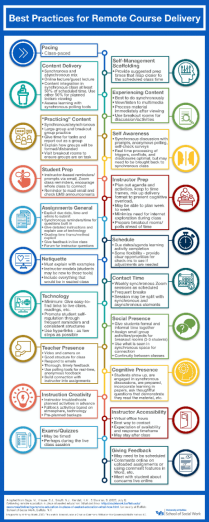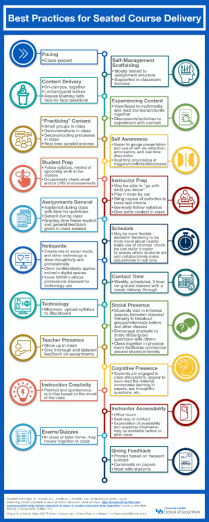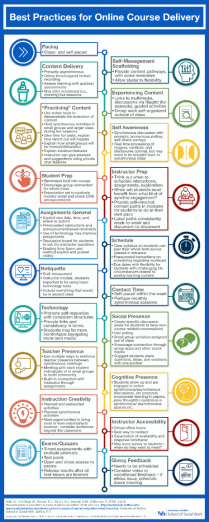Delivering Remote Education in Place of Seated Education Infographics
These infographics depict best practices to facilitate creating and maintaining a quality educational experience for both students and faculty across various modes of instruction delivery.
Each infographic captures key considerations for an identified mode of learning (remote, seated, or online) based on this resource created to guide instructors across disciplines in transitioning from seated to remote learning environments. This resource, developed by University at Buffalo School of Social Work faculty and staff members, explores in greater depth how experiences and expectations differ for instructors and students alike depending on the mode through which a course is delivered.
Best Practices for Remote Course Delivery
Remote course instruction maximizes elements of seated classes temporarily during times of disruption.
Generally, students who are engaged in remote learning initially intentionally enrolled in a seated program because such classroom settings are best matched to their learning. Accordingly, to establish and maintain a good person-environment fit for students who have had to pivot to remote learning, it is ideal to preserve as many elements of seated instruction as possible. This will facilitate such students receiving an educational experience that is as congruent with that which they originally selected as possible.
Best Practices for Seated Course Delivery
Seated course instruction is place-based, face-to-face, and conducted in real time.
Seated classes structure learning in a social context as students synchronously remain in the presence of the instructor and fellow students. Seated students tend to differ from fully-online students in their experiences and expectations related to social presence, self-regulation, the use of technology in their learning.
Best Practices for Online Course Delivery
Online course instruction is facilitated using technology and is optimized for a virtual student population.
Online instruction structures learning through self-paced modules, most of which are asynchronous. Students engaged in online learning are expected to possess and mobilize strengths in self-management and organization to learn independently. Students who choose this mode of course instruction often do so based on having prior experience with online learning.


